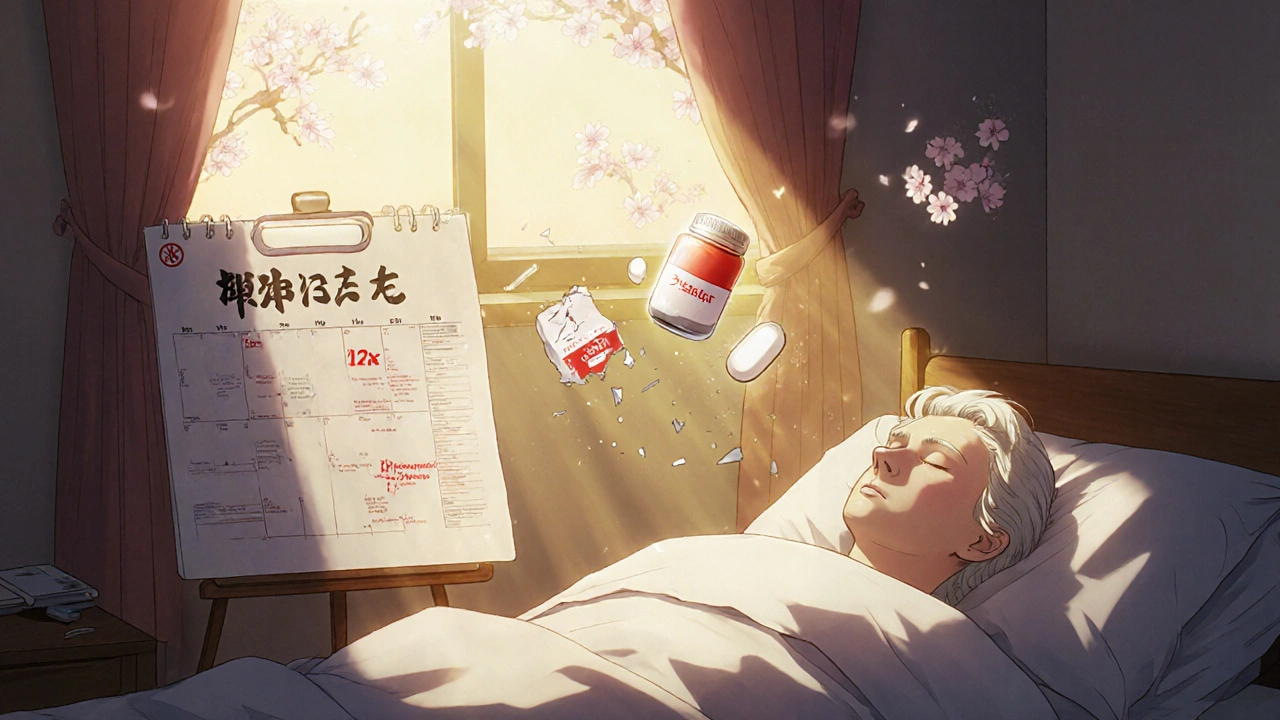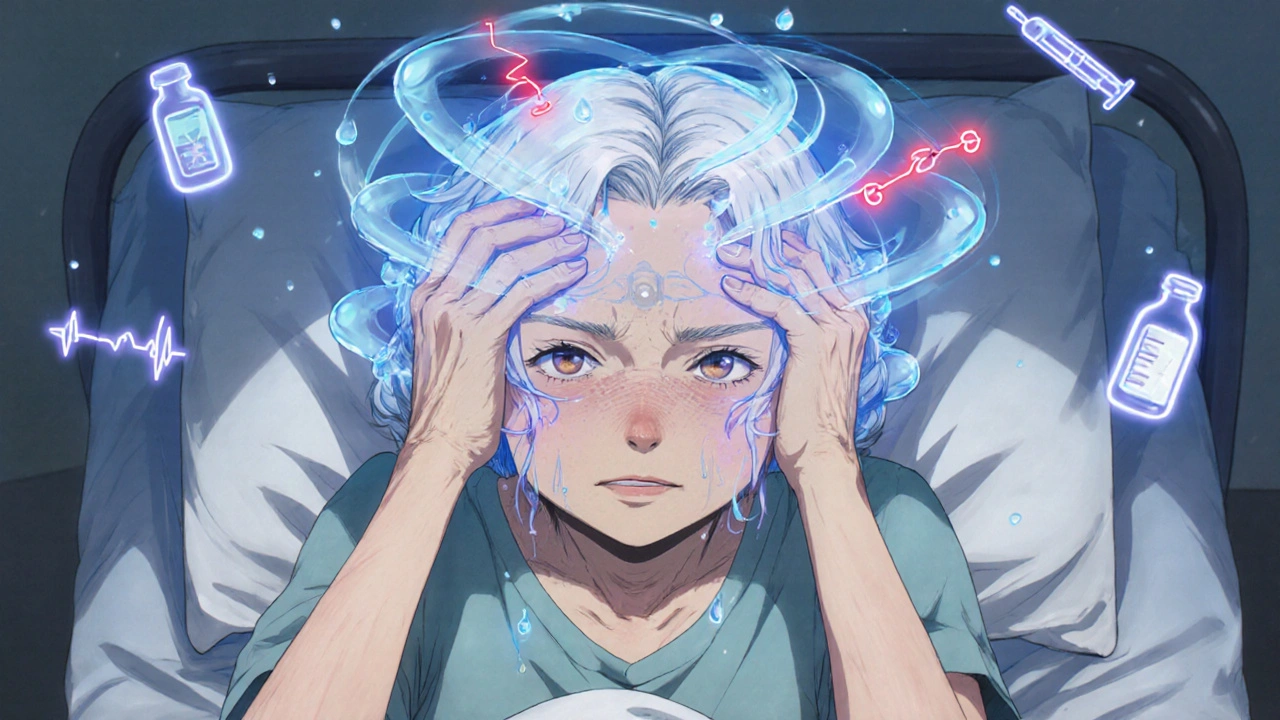Hyponatremia Risk Calculator
Calculate Your Hyponatremia Risk
Hyponatremia (low blood sodium) is a dangerous side effect of SSRIs, especially for elderly patients. This calculator estimates your risk based on key factors.
Input Your Risk Factors
Results
What to Do Next
When you start an SSRI for depression, you expect better mood, more energy, maybe a good night’s sleep. But for some people-especially those over 65-something far more dangerous can happen: hyponatremia. That’s when your blood sodium drops too low, and your brain starts to swell. The symptoms? Confusion, dizziness, nausea, headaches. In severe cases, seizures, coma, or even death. This isn’t rare. It’s one of the most common and serious side effects of SSRIs, yet most patients never hear about it before they start taking the drug.
How SSRIs Cause Low Sodium
SSRIs like sertraline, citalopram, fluoxetine, and paroxetine work by increasing serotonin in the brain. That’s how they help with depression. But serotonin doesn’t just affect mood. It also talks to your kidneys and brain through receptors that control how much water your body holds onto. When serotonin levels rise too much, your body releases too much antidiuretic hormone (ADH). This hormone tells your kidneys to hold onto water instead of flushing it out. The result? Your blood gets diluted. Sodium levels drop. You end up with hyponatremia-serum sodium below 135 mmol/L.This isn’t a slow, quiet process. It usually happens within two to four weeks of starting the medication or increasing the dose. That’s why so many cases are missed. Doctors and patients assume confusion or fatigue in older adults is just part of aging. But it could be your sodium dropping dangerously low.
Who’s at Highest Risk?
Not everyone on SSRIs gets hyponatremia. But some groups are at much higher risk:- People over 65 - Their kidneys don’t handle fluid as well, and their hormone systems are more sensitive. Incidence hits 13.9% to 18.6% in this group.
- Women - Over 65% of documented cases are in women, likely due to body composition and hormonal differences.
- People on diuretics - Especially thiazide diuretics like hydrochlorothiazide. Using them with an SSRI raises your risk by over four times.
- Those with low body weight - Under 60 kg? Your blood volume is smaller. Even a small water gain can tank your sodium.
- People with kidney problems - If your eGFR is below 60 mL/min, your body can’t clear excess water effectively.
A 78-year-old woman in a 2022 case report developed sodium levels of 118 mmol/L-life-threateningly low-just 10 days after starting sertraline. She ended up in the ICU. Another case from early 2024 involved an 82-year-old woman whose family noticed she was “acting like a different person.” Her sodium was 122 mmol/L. She had been on citalopram for two weeks. No one told them this could happen.
How to Spot It Early
The early signs of hyponatremia are easy to miss:- Mild nausea or loss of appetite
- Headaches that won’t go away
- Feeling unusually tired or weak
- Confusion or trouble remembering things
- Balance problems or unexplained falls
These symptoms look exactly like dementia, depression worsening, or just getting older. That’s why it’s so often misdiagnosed. The average time from symptom start to correct diagnosis? Over seven days. By then, sodium levels may already be below 125 mmol/L-danger zone.
There’s no home test for sodium. But if you’re on an SSRI and start feeling off, especially within the first month, ask your doctor for a simple blood test. A serum sodium level is quick, cheap, and can save your life.

What Doctors Should Do
The American Psychiatric Association and the American Geriatrics Society now say: Test before you start. Baseline sodium should be checked within 7 days before beginning an SSRI. Then, test again at 2 weeks. For high-risk patients-those over 65, on diuretics, or with kidney issues-monthly checks for the first three months are recommended.If sodium drops below 135 mmol/L and you’re on an SSRI, the first step is almost always stopping the drug. For mild cases (125-134 mmol/L), fluid restriction to 800-1000 mL per day and stopping the SSRI usually fixes it in 72 to 96 hours. Severe cases-below 125 mmol/L-need hospitalization. Intravenous hypertonic saline (3%) is given slowly, no more than 6-8 mmol/L increase in the first 24 hours. Too fast, and you risk permanent brain damage from osmotic demyelination.
Alternatives to SSRIs That Are Safer
Not all antidepressants carry the same risk. Here’s what the data shows:| Medication | Risk Relative to SSRIs | Notes |
|---|---|---|
| Citalopram | 2.37x higher | Highest risk among SSRIs |
| Sertraline | 2.15x higher | Very commonly prescribed |
| Fluoxetine | 1.98x higher | Long half-life, risk lasts longer |
| Paroxetine | 1.82x higher | Also causes more dry mouth and constipation |
| Venlafaxine (SNRI) | 1.72x higher | Still higher risk than non-SSRIs |
| Amitriptyline (TCA) | 1.94x higher | Older drug, more side effects |
| Bupropion | 0.85x (lower) | Doesn’t affect serotonin; safest SSRI alternative |
| Mirtazapine | 0.47x (much lower) | Best choice for elderly patients |
For older adults, mirtazapine is now the go-to alternative. It works differently-it doesn’t boost serotonin the same way. It’s not perfect (it can cause weight gain and drowsiness), but its hyponatremia risk is less than half that of SSRIs. In fact, for every 1,000 elderly patients switched from SSRIs to mirtazapine, about 12 cases of hyponatremia are prevented each year.

Why This Isn’t Common Knowledge
Only 28.7% of patients surveyed in 2023 said they were told about hyponatremia risk before starting an SSRI. And 63.4% of primary care doctors didn’t know the typical onset window was 2-4 weeks. That’s not because they’re careless. It’s because this risk has been buried in fine print for years. FDA labeling now requires hyponatremia warnings, but many prescribers still don’t read them.Meanwhile, prescribing patterns are changing. Between 2018 and 2023, SSRI use in patients over 65 dropped 22.3%. Mirtazapine prescriptions for the same group jumped 34.7%. The cost of treating SSRI-induced hyponatremia in the U.S. alone? Over $1.27 billion a year-mostly from ER visits and hospital stays that could have been avoided.
What You Should Do
If you or a loved one is on an SSRI:- Ask for a baseline sodium test before starting.
- Request a repeat test at 2 weeks.
- Watch for confusion, nausea, or unexplained fatigue-especially in older adults.
- If you’re over 65, ask if mirtazapine or bupropion might be a safer option.
- Don’t assume confusion is “just aging.” Low sodium is reversible. Dementia isn’t.
Depression is serious. But so is hyponatremia. You don’t have to choose between treating your mood and risking your brain. With the right testing and alternatives, you can do both safely.
Can SSRIs cause confusion in elderly patients?
Yes. SSRIs can cause confusion in elderly patients by triggering hyponatremia-low sodium in the blood. This happens because SSRIs increase serotonin, which causes the body to retain too much water, diluting sodium levels. Symptoms like confusion, disorientation, dizziness, and memory problems are common signs. These are often mistaken for dementia or normal aging, but they can be reversed by stopping the SSRI and correcting sodium levels.
How long does it take for hyponatremia to develop on SSRIs?
Hyponatremia usually develops within two to four weeks after starting an SSRI or increasing the dose. It’s rare before two weeks and uncommon after six weeks. That’s why doctors recommend checking sodium levels at the 2-week mark-early enough to catch it before it becomes severe.
Which SSRI has the lowest risk of hyponatremia?
None of the SSRIs are low-risk. All carry a significant risk, especially in older adults. Citalopram and sertraline have the highest risk. Paroxetine and fluoxetine are also high. If you’re at risk, switching to a non-SSRI like mirtazapine or bupropion is safer. Mirtazapine has less than half the hyponatremia risk of SSRIs and is now recommended as first-line for elderly patients.
Is hyponatremia from SSRIs reversible?
Yes, in most cases. If caught early, stopping the SSRI and restricting fluids can bring sodium levels back to normal within 72 to 96 hours. In severe cases (below 125 mmol/L), hospital treatment with IV saline is needed, but recovery is still likely if corrected slowly. The key is early detection-delayed treatment can lead to permanent brain damage from osmotic demyelination.
Should I stop my SSRI if I feel confused?
Don’t stop abruptly without talking to your doctor. But if you’re feeling confused, dizzy, nauseous, or unusually tired-especially if you’re over 65 or on a diuretic-ask for a blood test to check your sodium level. If it’s low, your doctor will likely advise stopping the SSRI and may switch you to a safer antidepressant like mirtazapine. Never ignore new neurological symptoms while on an antidepressant.
Are there any antidepressants that don’t cause hyponatremia?
Yes. Mirtazapine and bupropion have significantly lower risk. Mirtazapine is the safest option for elderly patients-it doesn’t increase serotonin the same way SSRIs do. Bupropion works on dopamine and norepinephrine, not serotonin, so it doesn’t trigger SIADH. Both are recommended by the American Geriatrics Society as alternatives to SSRIs for older adults.


Author
Mike Clayton
As a pharmaceutical expert, I am passionate about researching and developing new medications to improve people's lives. With my extensive knowledge in the field, I enjoy writing articles and sharing insights on various diseases and their treatments. My goal is to educate the public on the importance of understanding the medications they take and how they can contribute to their overall well-being. I am constantly striving to stay up-to-date with the latest advancements in pharmaceuticals and share that knowledge with others. Through my writing, I hope to bridge the gap between science and the general public, making complex topics more accessible and easy to understand.